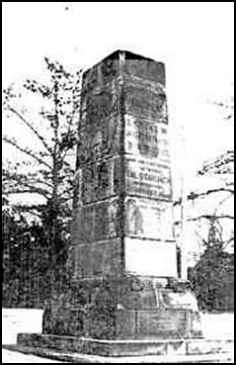
 |
|
from American Legion website |
EMILIO CARRANZA CRASHED IN 1928 IN PINE BARRENS BY THOMAS BARLAS, Staff Writer, (609) 272-7201 from The Press of Atlantic City Sunday, July 10, 2005 TABERNACLE It's a blunt hunk of limestone in the middle of nowhere, dedicated to a man whose name is recognized by fewer and fewer people each year. And when people hear of Emilio Carranza, they wonder why such a fuss is made over a guy who crashed a plane into a pine forest almost 80 years ago. They sort of smirk when they hear Carranza's nickname - the Lindbergh of Mexico - and ask why, if he was such a good aviator, he didn't make it to his destination. The folks who know about Carranza gathered for the 77th time Saturday in Wharton State Forest here to commemorate his death. The service drew about 100 people, a little fewer than usual, according to those who regularly show up for the event. Despite the best attempts by members of American Legion Post 11 in Mount Holly, whose predecessors found Carranza's body and who today do all they can to keep his memory alive, there's a worry that his legacy will dwindle like the crowds that attend the yearly service. But there was something new at the Carranza monument Saturday: An interpretive plaque put up by the state Division of Parks and Forestry that explains not only about Carranza, but the reason for the monument. The plaque was prompted by last year's defacement of the Carranza monument - an incident that caused conservationists to work for days to remove a swastika and racist slogans. Division Director Jose Fernandez said the incident caused the state to realize just how unique Carranza is to New Jersey's history. "Think about it," he said. "An American Legion post in Mount Holly has been doing this for a Mexican aviator for more than 70 years. It's amazing." By his early 20s, Carranza was Mexico's most famous aviator. In 1928, Carranza came within 300 miles of completing a nonstop flight from Mexico City to Washington, D.C. He made it after a stopover in North Carolina. On July 12, 1928, the 22-year-old Carranza planned to take off from New York City for a nonstop flight back to Mexico City. But the weather was poor. U.S. officials forbade Carranza from flying in the raging thunderstorm. Carranza left after getting a telegram from his superior officer, who cabled, "Leave immediately without excuse or pretext, or the quality of your manhood will be in doubt." Carranza took off at 7:18 p.m. from Roosevelt Field. It was the same field from where Charles Lindbergh began his historic solo flight across the Atlantic Ocean. The weather grew worse. Carranza historians believe he held a flashlight out the window of his plane in an attempt to find and use railroad tracks as a directional guide. There was no news of Carranza's flight until about 3:30 p.m. the next day, when a young boy picking blueberries in the pines here found a wing of what turned out to be Carranza's airplane. A later search turned up Carranza's body and the rest of his airplane. Carranza was still clutching the flashlight when searchers found his body. The telegram that prompted his flight was found in a pocket of his flight suit. The reaction to Carranza's death was, compared with the small crowds who attend the yearly services here, overwhelming. President Coolidge offered to send Carranza's body back to Mexico on the battleship USS Florida. According to newspaper reports, more than 200,000 people lined Broadway for his funeral procession through New York City, and cannons boomed in salute. Thousands gathered in Trenton to watch his funeral train pass through the city. If Carranza's memory needs some bolstering here these days, it's still big in Mexico, where he remains a national hero. "It was unheard of for Mexico," Erika Spezia, the Mexican counsel general in Philadelphia, said of Carranza's aviation skills after placing a wreath at his monument Saturday. Marlton resident Elizabeth Moore started attending the Carranza memorials 10 years ago after returning from Mexico City, where she lived for some time. A section of Mexico City's airport has murals and photographs dedicated to Carranza that prompted her interest in attending the annual ceremonies, she said. If nothing else, those who gather every year to remember Carranza are sincere. They talk about Carranza being a goodwill ambassador trying to improve relations between Mexico and the United States. State officials made a new pledge Saturday to protect Carranza's monument and help preserve his name. The crowds that honor Carranza are certainly smaller than in 1928. Spezia said that's all right with her. "It's the spirit that counts," she said. All rights reserved. |
AMERICAN LEGION Post 11 Mount Holly, NJ The Martyr Aviator of Mexico The Rest of The Story Emilio Carranza Unites Nations Emilio's Mission His Spirit Arrives Thru The Air Carranza 2008 Directions To The Carranza Memorial As you read this story, you will come to know him as one of Mexico's most distinguished heroes of aviation. In addition, you will learn of the unique relationship between the Mount Holly American Legion Post 11 and the Mexican government and people. |


|